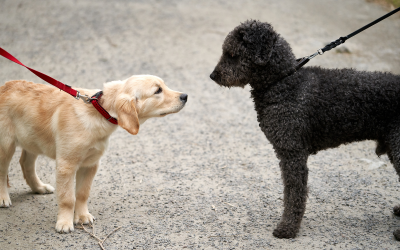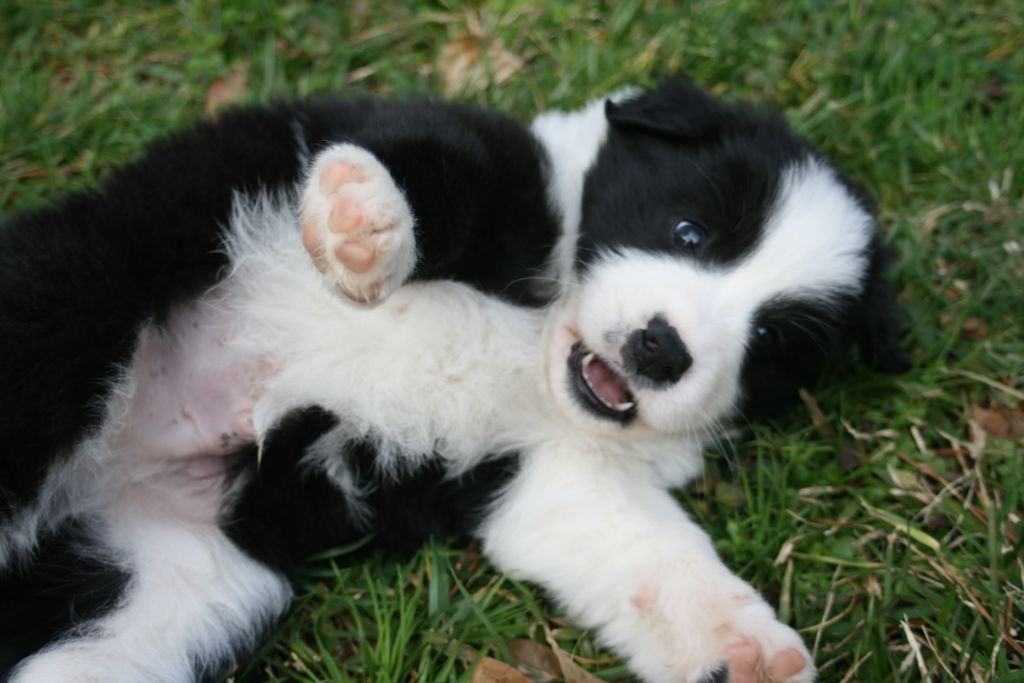Why On-Leash Greetings Aren’t Always Best
Look, I hate to always be the spoilsport. I know it’s tempting to encourage your dog to make new friends, especially if he’s digging it. (Ha. digging it.) But greeting other dogs while on-leash may not always be the best choice for your dog.
See, dogs prefer to greet other dogs in a very specific manner. In an ideal off-leash greeting, a social dog approaches in a banana-curve with a loose body, quickly sniffs nose → rear end → nose again, then moves on or plays. They don’t stand around awkwardly while their people stare at them urging them to be friends. So humiliating.
Polite Passing vs. Pulling Greetings
Psst. On-leash greetings undermine polite walking skills. The goal for passing another dog is exhibiting only mild interest. Need help getting there? Schedule a visit!
Fight or Flight
On-leash greetings can create too much tension. Dogs (and people) get tangled in leashes, and a dog’s flight option is eliminated—leaving only fight. Even the sweetest dog can snap when they feel trapped.
Reduced Communication
Dogs read very subtle body language and rely on displacement behaviors (like sniffing) to alleviate stress. Forced on-leash greetings hide those signals and can trigger reactivity.
Not All Dogs Want to Socialize
Dog sociability often declines after age 5. Some dogs—like some people—just don’t want to greet every stranger. Respect their boundaries.
Reinforcing Bad Habits
A little pulling “between friends” still reinforces pulling. Do you really want your dog to get better at pulling?
Safer Ways to Socialize Your Dog
Appropriate greetings take practice. If your dog is interested in new friends, try these instead:
A Few Good Friends
Use a securely fenced yard to let compatible dogs play. Supervise, give frequent breaks, and end on a high note before they’re exhausted.
Parallel Walks
Walk side-by-side with a friend and their dog. Your dogs get social time without face-to-face pressure, and you both get exercise (and fresh air!).
Trail Walks
Hit the trail on-leash for enrichment sniffing. Single-file walking lets dogs share an activity without the stress of greeting.
Dog parks aren’t the only option—network with fellow owners to set up small, structured playdates with known, savvy dogs.
If You Must Allow On-Leash Greetings
- Agree on a plan with the other handler.
- Keep leashes loose—if either dog can’t greet on loose leashes, call it off.
- Watch for tense body language. Know the warning signs.
- If you feel uncomfortable, end the interaction immediately.
- No play on leashes—dogs can get tangled and injured.
- Limit greetings to the nose→butt→nose sequence (max 8 seconds).
- Don’t tighten leashes to move dogs apart—call your dog on a loose leash instead.
- Stay calm, stay aware, and protect your dog from bad situations.
Now get out there and walk your dog on the opposite side of the street from your neighbors!
And don’t forget your treats!
Ready to Train Smarter (Not Harder)?
Dog training with Good Human Dog Training gives you more than just a polite pup; it gives you peace of mind. Whether you’re wrangling a wild puppy, managing reactivity, or just tired of being dragged down the block, we’ve got a plan for you.
Let’s make training click for both of you.
Schedule Services



